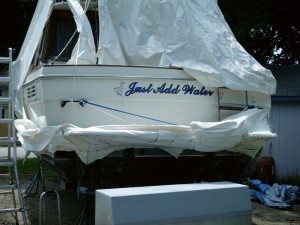Just add water – such a simple concept when you’re making instant oatmeal or hot chocolate, but not so simple when you’re trying to commission a boat on the hard, early in a New England spring.
It’s April 3 in southern New England, and I have all my paints, varnishes, thinners, brushes, masking tape, tack cloths and rags poised in carryalls in my warm workshop. I have my overalls, kneepads, tools and boatyard ladder in the back of the car. Yes, I am chafing at the bit to make my two old and small wood boats – collectively, more than 140 years old – stand tall for yet another season.
 But this morning, the temperature is below freezing; the wind is honking 20 to 25 knots out of the northwest, gusting to 55 along the coast. I was looking at an occasional wind-chill factor of 11 degrees as I started a somewhat melancholy walk along the shore, having decided that if I can’t work on my catboat, I can hang out near her and dream.
But this morning, the temperature is below freezing; the wind is honking 20 to 25 knots out of the northwest, gusting to 55 along the coast. I was looking at an occasional wind-chill factor of 11 degrees as I started a somewhat melancholy walk along the shore, having decided that if I can’t work on my catboat, I can hang out near her and dream.
Two weeks ago, in spring-like weather, I spotted my first egret – a great egret with all-black legs and feet – in a little marsh in back of the marina. The previous week, I saw my first pair of ospreys soaring over the bay. This day, no life was visible in the estuary, not even the hardy “red-legger” black ducks, down from the prairie provinces, that are usually feeding on shellfish in lees under creek banks.
A molten-pewter sky churned toward me from the west as I continued toward the marina, whose owner greeted me, yelling above the roar of the wind, “What a low tide!” I peered out through the trees and saw a mast leaning at a 45-degree angle. Upon further inspection, I saw that the mast was stepped on the only boat that had wintered on a mooring in the anchorage. The sloop was sitting ingloriously on mud, and the anchorage was mostly flats, dotted and laced with pools and channels.
It was Basic Piloting 101, as the forces of moon and wind revealed the true nature of the bottom more eloquently than any chart could tell the tale. More flats were bared at the entrance to the harbor, between the point and the nun, which I cut dismissively in the spring and summer. Upon my return home, I checked the tide tables, which said that the low tide was about two inches below chart datum – average figures – and that number would climb to more than eight inches below datum in the following two days.
The wind rose, bullied me about, and threatened to blow me off my feet. The billowing battleship-gray clouds drew near, piled on, and spit huge, wet flakes that obscured the opposite shore. I couldn’t pass my boat without lifting the cover and smelling her sweet, dry interior, which told me she had wintered well.
The forecast for the next day called for snow in the morning and snow and sleet in the afternoon. East winds would blow five to 10, becoming north and gusting to 20 in the afternoon. That night, snow was predicted, for a total accumulation of five to eight inches, with north winds of five to 10 gusting to 20. Perhaps I can start outside work next week, I thought.
Before I drove home, I took another look at the harbor and the grounded sloop, which, through the pixilated screen of the snow, looked more like an elephant in the fabled tar pits waiting to die than it did a sailing vessel. My bleak mood did not improve.
Yes, I enjoy spring maintenance and repair of old boats as much as running them. Not only do I like to repay them for all the pleasures they have given me, I also cherish the process of revival and restoration the season represents. I look forward to the season of reacquaintance – with yard employees and marina patrons and neighbors, who have showed me kindnesses over the years. And all winter long, I await my rendezvous with the boatyard dogs, ships’ cats, great blue herons, kingfishers, egrets (both great and snowy), and the ospreys. For me, all these creatures – winged, two-legged and four-legged – make spring commissioning a precious experience. I must be patient.




 We have complete issues archived to 2009. You can read them for free by following this link.
We have complete issues archived to 2009. You can read them for free by following this link.